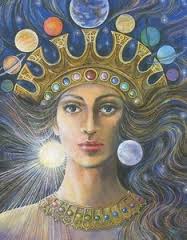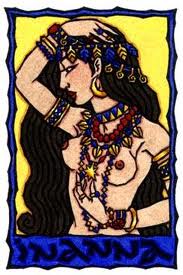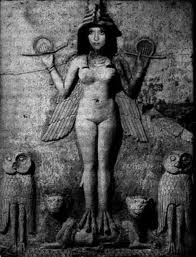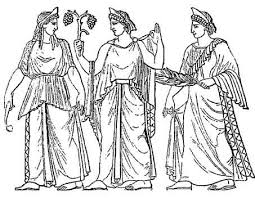The other day I woke from an undifferentiated dream with the words, “verbs, nouns, and scarlet adjectives” in my head. When I considered this word cluster, after a cup of coffee, I determined that its key word was “scarlet.” I pondered the word “scarlet” over the next few days. My train of thought, Google, and most importantly The Woman’s Encyclopedia of Myths and Secrets by Barbara Walker all reminded me of an enormous cover-up perpetrated by the Judeo-Christian patriarchy.
Not to put too fine a point on it.
Scarlet. I asked myself, and several other people, what that word conjures. Literally everyone said either The Scarlet Letter or “a scarlet woman” or both. Scarlet + woman = fall from grace, shame, sin. In other words, whore, harlot, hussy, slut. The original scarlet woman, it turns out, was the woman who has come down to us as the Whore of Babylon. In Revelations, chapter 17, we are told just how horrific this woman (spoken with dripping scorn and indignant rage) was. A few choice quotations:
- “Come hither. I will shew unto thee the judgment of the great whore that sitteth upon many waters with whom the kings of the earth have committed fornication, and the inhabitants of the earth have been made drunk with the wine of her fornication….”
- And shortly thereafter: “I saw a woman sit upon a scarlet coloured beast, full of names of blasphemy…. And the woman was arrayed in purple and scarlet colour, and decked with gold and precious stones and pearls, having a golden cup … full of abominations and filthiness of her fornication.”
- And last but not least: “And upon her forehead was a name written, MYSTERY, BABYLON THE GREAT, THE MOTHER OF HARLOTS AND ABOMINATIONS OF THE EARTH.”
But let’s back up a bit. Like 3 or 4 thousand years. Harlot, the word so contemptuously used by the writers of the Book of Revelation in the Old Testament, was originally the name for the sacred priestesses who served the Great Goddess Har, also known as Ishtar. From the word “har” came other words, such as “hara,” a Hebrew word for great mountain or pregnant belly, and Harmonia, a daughter of Aphrodite and bringer of peace. The Greek “horae,” the Persian “houris,” or the Hebrew “hor” (“synonym for the sacred prostitute and the Goddess she served”*) are all etymologically linked to the word “whore.” But the fact is, sacred “harlots,” and priestesses of the goddess Har, or Ishtar, were powerful and honored, in fact revered, members of pagan societies.
Words that mean one thing for thousands of years: co-opted and degraded in a matter of a few hundred years by one male-dominated institution.
Let me continue. The scarlet woman—often seen wearing the red (and/or purple) of divinity—was first of all the great Ishtar, aka Queen of Heaven aka the Great Whore of Babylon. She called herself “a prostitute compassionate” and she and her priestess harlots were “honored like queens at centers of learning in Greece and Asia minor.” Despite her reverenced position throughout the ancient world, she comes to us via the Bible as “the mother of abominations,” among other things.
Some of these priestess-whores actually did become queens. Justinian’s bride, Theodora, was a temple harlot before she said, “I do.” The Emperor Constantine’s very own mother, now canonized (St. Helena), was a harlot before she became an empress/saint. Gosh why don’t Western histories tell us this stuff?
So, countless ancient yet sophisticated cultures including the Egyptians, Babylonians, Greeks, Persians, Hindus, Japanese—all revered women whose lives were spent in temples, as hierodules (representing the goddess on earth) having sex with men (often priests), who were honored as healers (their vaginal secretions and spit were said to have healing powers), and who were valued as brides when their service in the temple was over. Very, very cool.
That was back when sex was not a sin, women were not only allowed to be sexual beings but adored for their sexual powers, and when “virgin” meant unmarried woman. You’ve probably heard of the “Vestal virgins?” Well what you were not told is that most if not all the priestesses who looked after temples were virgins. Meaning they chose to remain unmarried. And have as much sex as they wanted in their roles as priestess-virgins.
Now, of course a “whore” is a term of degradation and contempt. Young women are hog-tied by the idea that “virgin” means “girl who does not have sex” instead of independent woman who is allowed to make her own sexual choices. Rethinking the mother of Jesus—we were told she was a virgin when her womb quickened with humankind’s savior. Well, according to the meaning of “virgin” at the time (aka the original meaning of that word), that meant she was not married. It did not mean she had not had sex.
How did this complete co-opting of language (nouns, verbs and scarlet adjectives) happen? Easy. The rise of the Christian church put the kibosh on anything that smacked of feminine power. Whores held significant status in pagan culture, so they had to be brought low. Powerful and influential men literally stole the truth, rewrote history, and at a time when literacy was low and there was soon a church in every village, the redirection of language was achieved efficiently and brutally.
Typical example. The horae of Aphrodite—her “celestial nymphs, who performed the Dances of the Hours, acted as midwives to the gods, and inspired earthly horae (harlot-priestesses) to train men in the sexual mysteries”*—were magically transformed by the church into virgins (the kind who don’t have sex), martyred, and turned into three maiden saints—Agape, Chionia, and Irene. Done.
Another example. In Iceland, a very matriarchal society at that time, every woman worshipped the goddess in her own home, on her own hearth. This woman was known as a “hussy,” and typically shared her “hus” (which meant both home and place of worship) with more than one “hus-band.” But when Iceland agreed in about 1000 AD to become Christian, guess what? The word hussy became a derogatory term. Done.
The Christian patriarchy seemed to be all about taking the power to choose away from women, a woman’s power over her own body being a prime example. At first glance one might think, how can anyone take one’s power to choose, or to control what she does with her body, away from a woman? We all know how it’s done today. Through public opinion, rape and the perpetuation of rape culture, legislation, and any number of societally accepted norms (from pay scales to product marketing) that marginalize and diminish women, or try to. And often succeed.
As the Catholic orthodoxy rose to prominence in Western and Eastern Europe, a woman with a lover became indistinguishable in the eyes of the church from a professional prostitute. Both were considered “whores.” In fact, women who gave their love and body freely to a lover were tortured in hell as viciously as the reviled prostitutes. St. Augustine and others depicted the torments reserved for sexually active women (whether lovers or whores) as being among the very worst—greater than those for murderers, for example.
We have inherited this twisted view of women and language—whereby both the women themselves and the words that described them have been repainted by a society hell-bent on destroying the truth and keeping women “in their place.” Though no longer considered the property of men, women are still either actively treated as objects or allowed by much of the bystanding populace to be objectified day after day on billboards, on Twitter, by Hollywood, you name it.
It would be lovely to reclaim our “nouns, verbs, and scarlet adjectives” in the pursuit of a genuine equality. It bothers me, I must admit, that history seems to begin, in the minds of 99% of the world, after women’s power was systematically stolen from them. Part of empowering women and men is to resurrect the truth and at least have a working knowledge of what the words that are used to shame, control, and demean women actually mean.
Scarlet. The color of a woman’s power, a woman’s sexuality, a woman’s direct connection to the divine. It has become my favorite word.



